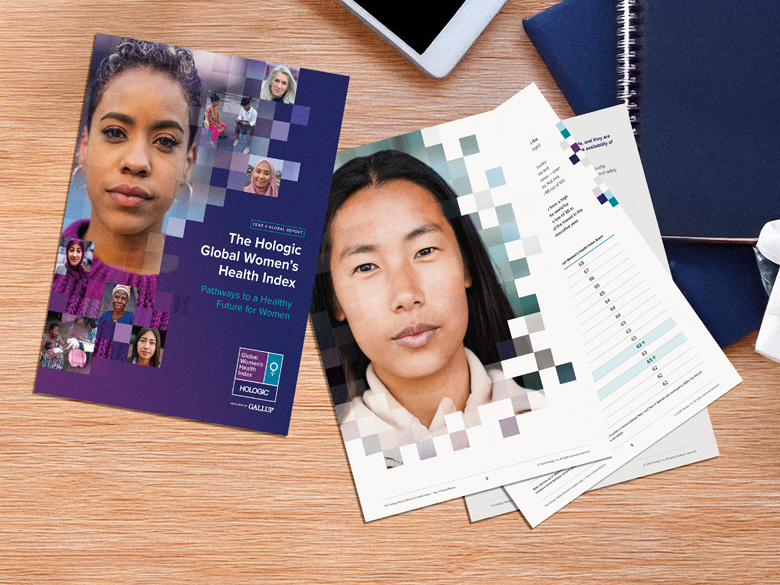Methodology
Guided by Researchers, Health Experts & Data Scientists
Below is a detailed description of the study development and methodology. Additional information can be found in the Hologic Global Women’s Health Index.

Developing One of the World’s Most Comprehensive Studies of Women’s Health
With a team of global experts, Hologic and Gallup set out to understand which key metrics would be most meaningful to study in a women-focused, international index of health built on national-level surveys conducted worldwide.
Women’s health encompasses physical health at the intersection of her social, economic, and political identities, and the ways in which her culture, her socioeconomic status, stressors associated with discrimination, experiences with violence, her access to quality and affordable health services, and her geographical location all influences the choices she is able to make for her wellbeing, and that of her family. But not all of the issues facing women today can be measured in a non-epidemiological social science survey.
3 Key Survey Objectives
With the guidance of Gallup, multiple experts and existing knowledge sources, Hologic identified three key objectives of the survey:
Capture knowledge, attitudes and behaviors (KAB model) related to health.
Focus on female-specific health issues.
Bring attention to actionable areas to increase female life expectancy.
These three objectives guided the development of the 10 closed-ended survey questions that make up the Hologic Women’s Health survey module that is a part of the Gallup World Poll.
The Hologic Women’s Health Survey Module
Ten closed-ended survey questions, in combination with other well-established World Poll questions (general health and quality of life, opinions of available general healthcare, safety and victimization, food and shelter insecurity, and emotional health and well-being), are what make up the Hologic Global Women’s Health Index.
To consistently and accurately collect data on the same indicators from a representative sample of respondents in different countries, Gallup tested these questions to ensure clarity and precision so that they are easily translated, well understood, and similarly interpreted across cultures.
10 Closed-Ended Survey Questions:
WHY IT MATTERS:
Knowledge and attitudes toward preventive healthcare are the first two dimensions of “knowledge, attitudes and behaviors theory” (KAB). KAB is a health behavior theory of change wherein the change in human behavior is divided into three successive processes, namely, acquisition of the right knowledge, generation of attitudes and adoption of behaviors (or practices).
WHY IT MATTERS:
Knowledge and attitudes need to lead to concrete behaviors, which are shaped by individual and social barriers.
WHY IT MATTERS:
Heart disease is the leading cause of death in both men and women (CDC, 2020b).
WHY IT MATTERS:
Men and women are susceptible to different types of cancer, and testing is crucial to early diagnosis and increasing the odds of successful treatment (CDC, 2020a).
WHY IT MATTERS:
Obesity and diabetes-related diseases are a growing concern around the world and are associated with heart disease, as well as increased incidence of certain cancers (CDC, 2021b).
WHY IT MATTERS:
Perceptions of the quality of prenatal care are lacking in global statistics–a critical dimension of women’s healthcare experiences over the course of their lives.
WHY IT MATTERS:
A woman’s age of first pregnancy and number of children have a strong relationship with years of education, employability, household income, time available to manage personal health, mental health, etc. (PRB, 2011; UNFPA, 2021; UNICEF, 2021; World Bank, 2021).
WHY IT MATTERS:
Perceptions of widespread domestic violence can vary for different groups (e.g., men vs. women). In addition, the psychological burden of believing domestic violence is widespread could be tied to negative well-being outcomes.
WHY IT MATTERS:
STDs/STIs have an outsized impact on women’s reproductive health and fertility (compared to men) (CDC, 2021a).
WHY IT MATTERS:
A woman’s age of first pregnancy and number of children have a strong relationship with years of education, employability, household income, time available to manage personal health, mental health, etc. (PRB, 2011; UNFPA, 2021; UNICEF, 2021; World Bank, 2021).
Survey Methodology
Gallup’s vast network of globally distributed data collection partners, liaisons with government contacts and regional expertise formed the infrastructure on which the Hologic Global Women’s Health Index stands.
Throughout 2023, we surveyed nearly 78,000 women and girls (aged 15 and older) in 142 countries and territories in more than 140 different languages to assess the multiple dimensions that contribute to women’s health.
The survey collects demographic information about participant age, gender, income, education level, household size and location (urban vs. rural). In addition, Gallup used random sampling methodologies appropriate to each country and then weighted the data based on the most recent census or other reliable sources so that country results are representative of the total population. The survey’s quantitative results leverage the Gallup World Poll’s gold standard in globally representative polling.



